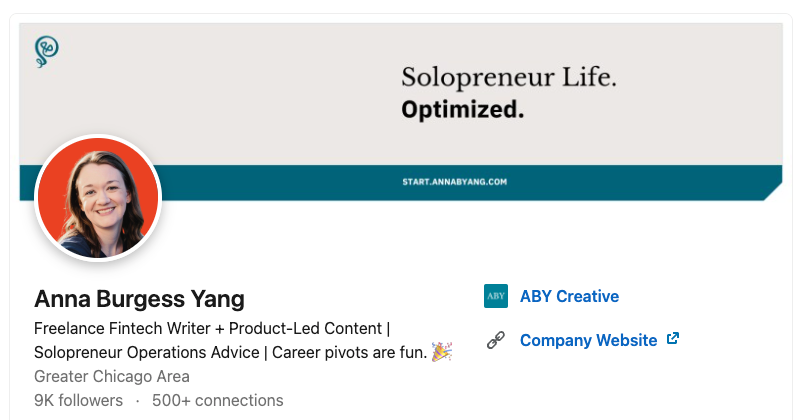6 Ways to Market Yourself as a Freelancer (Without the Hard Sell)
Don’t like cold pitching? You can still grow your business.

Making the leap to full-time freelance work can be scary.
You may have a killer project management system, be comfortable with freelance finances, and know how to draft a contract for your services. But there is often a big unknown when you leave the 9–5 world:
How will you land clients? Especially if you hate sending cold pitches?
Long before I became a full-time freelancer, I had been “marketing myself” — sometimes intentionally, sometimes unintentionally. The result? A pipeline that never dries up.
Here are some tactics you can use to help clients find you (and know they want to work with you before they even reach out).
1. Be active on LinkedIn
I know…. LinkedIn can be cringe sometimes. But as a business platform, there isn’t much better for finding high quality clients.
Potential clients find me through LinkedIn because I actively comment on other people’s posts. My headline makes it clear what I do. I get a lot of inbound DMs on LinkedIn from people who see my name and title, look at my profile page on LinkedIn, and decide to send me a message.

Long before LinkedIn became the social platform it is now, I would connect with anyone and everyone I’d met professionally. LinkedIn was my “digital Rolodex,” so to speak.
I began posting once a week — whatever popped into my head — as a way to keep in touch with my connections. Once a week became twice a week. I began to gain followers (using Creator mode) and increased my posting even more. My posts are a combination of my expertise and my personality.
LinkedIn is like telling every potential client what you’re like to work with — and you can do it in a way that feels authentic to you. Because if you show up as your true self, you’ll attract the clients that the right fit.
To make the most out of LinkedIn:
- Post consistently (at least 2x per week to start)
- Comment on posts from people in your industry or potential clients
- Have a clear headline and header image that describe what you do
- Write an interesting “About” section
- Include a link to your portfolio
If people find your posts or comments interesting, their next step will be to click on your profile to learn more about you. And (hopefully) that will lead them to reach out.

2. Show up in communities
I’m in (checks notes) thirteen Slack communities and six Discord communities.
Sure, some are more active than others (and some are a complete ghost town). But you can participate a lot in the active channels. It’s an opportunity to talk to people in your industry (or fellow freelancers).
The result? You become known for my expertise and willingness to share information. At a minimum, it gets your name out into the world and at best, potential clients see your comments and reach out to you.
If you start talking with someone in a community, move that connection over to LinkedIn. Even if that person doesn’t need your services today, appearing in their feed with your consistent posts will remind them that you’re in their network, even if you don’t interact much in the community.
3. Maintain your portfolio
One of the best parts about being a freelancer is that, unlike the resume needed for a 9–5 job, you get to let your work speak for itself.
But while a resume only needs the occasional update (like when you start hunting for a new job), your portfolio should get much more frequent attention.
If you do any work for clients that will be published (writing, design, video, etc), keep track of the URLs once the work goes live. I use Airtable to keep track of every deliverable and every URL — even the work that doesn’t end up in my public portfolio might someday be useful.
The easiest way to maintain an online portfolio is through a site specifically designed for that purpose. Then you can link to that site from your home page and LinkedIn profile. Sites like Contently, JournoPortfolio, and Dribbble make it easy to add new projects.
You can also build a full-blown website using Wix or Squarespace, or create a public-facing Notion page. But you want it to be easy to update your portfolio and also look clean and professional.
Tip: My freelance contract includes language that I’m allowed to use any finished work for my own sales and marketing purposes. Unless the prospective client specifically requests that I remove that language, I know that I have permission to share the final result in my portfolio.
4. Create guest content
While you can establish your presence on social platforms like LinkedIn, you can also borrow another person’s audience by creating guest content.
Since this work is often unpaid, you should balance this effort against your paying clients — but the right guest content can open up a whole new world of opportunities.
For example, I pitch various blogs and offer to create guest posts. When it goes live, I’m featured on that company’s website, LinkedIn page, Twitter account, etc.
I also regularly appear as a podcast guest. These don’t take much of my time (usually an hour) and have the same impact: I’m tapping into someone else’s audience.
Medium is another example of a “borrowed audience.” If you submit to publications with the right readers, you’re potentially landing in front of prospective clients. Or you can view Medium as an extension of your portfolio and your online presence — letting clients see who you are.
5. Network like crazy
Never. Stop. Networking.
Communities and commenting on LinkedIn are a start. But the real magic happens in DMs and on calls. You might start with a comment but then hop into a DM for a follow-up chat.
Not all conversations need to be with prospective clients. I regularly chat with other freelancers. In some cases, they have referred work to me if the project isn’t a good fit for their skillset (and vice versa). Networking with other freelancers also gives the opportunity to collaborate.
For example, I featured a fellow freelancer in my newsletter, and she featured me in hers. It’s a variation of a guest post approach and “borrowing” that person’s audience.
Network “up” as much as you can: connect with people who have larger audiences than you. Some of the big creators won’t have time to respond to every DM, but if you find mid-sized creators (or people growing quickly), you can hitch a ride by connecting with them.
You should never view other creators as competitors. Find those that do similar or adjacent work to you. You offer something unique and you’ll be able to find clients that the other creator doesn’t serve.
6. Stay within your niche
If you try to sell services that you haven’t done before (or aren’t your area of expertise), it’s going to be a hard sell. Period.
You’re going to have to convince the client to take a chance on you when you don’t have the portfolio to prove your value.
The more you can develop and strengthen an area of expertise, the more you’ll differentiate yourself from other freelancers.
In the book Win Without Pitching, Blair Enns writes, “What the world needs, what the better clients are willing to pay for, and what our people want to develop and deliver, is deep expertise.”
Set yourself apart with a niche, establish your presence online, and let the clients come to you.
Check out my free eBook: 17 Smart Tools Solopreneurs Need to Start, Grow, and Scale.






